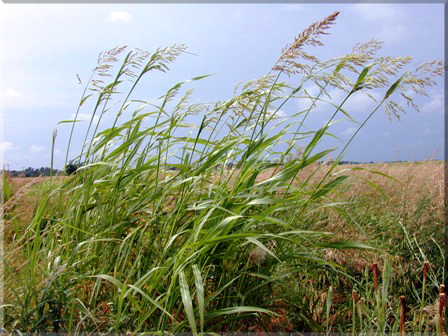Johnson Grass

Johnson Grass
 In the beginning, there was a pasture to weed, seed, fertilize and bush-hog. We had allowed a local farmer to take the hay without putting much in the way of care and maintenance back into it, so we had our fair share of weeds like horse nettle and Johnson grass, and it wasn’t going down without a fight. I swore at the Johnson grass, known for its stubbornness, and decided to cut the seed heads off to prevent multiplying my problem in the spring. So with scissors in hand and a huge sack on my shoulder, I took off to do the deed. After attacking one clump, I had a beautiful bouquet that would have made a festive harvest wreath for my door this fall, but considering this plant’s very aggressive nature, I decided that idea would not get me a seat on any homeowner’s association for sure.
In the beginning, there was a pasture to weed, seed, fertilize and bush-hog. We had allowed a local farmer to take the hay without putting much in the way of care and maintenance back into it, so we had our fair share of weeds like horse nettle and Johnson grass, and it wasn’t going down without a fight. I swore at the Johnson grass, known for its stubbornness, and decided to cut the seed heads off to prevent multiplying my problem in the spring. So with scissors in hand and a huge sack on my shoulder, I took off to do the deed. After attacking one clump, I had a beautiful bouquet that would have made a festive harvest wreath for my door this fall, but considering this plant’s very aggressive nature, I decided that idea would not get me a seat on any homeowner’s association for sure.
About half an hour after my attack on the grass, I was itching and breaking out in hives. Turns out, Johnson grass is at the top of the list for grass allergies. It can cause both skin rash and hay fever-like symptoms. Although the pasture is now devoid of any sign of Johnson grass, I can spot that stuff in every road-side ditch, abandoned lot and overgrown field for miles. The stuff is everywhere.
I am hoping for a beautiful stand of orchard grass this Spring that will surely perish in the heat waves we have been having in North Carolina. However, I like the words of my husband in his book Small-Scale Haymaking when he says, “There is something unique about the experience of haymaking. The process evokes a sense of nostalgia, a sense of accomplishment, and creates a relationship to the land that very few other farming endeavors engender.” (Besides alpaca farming, of course.)